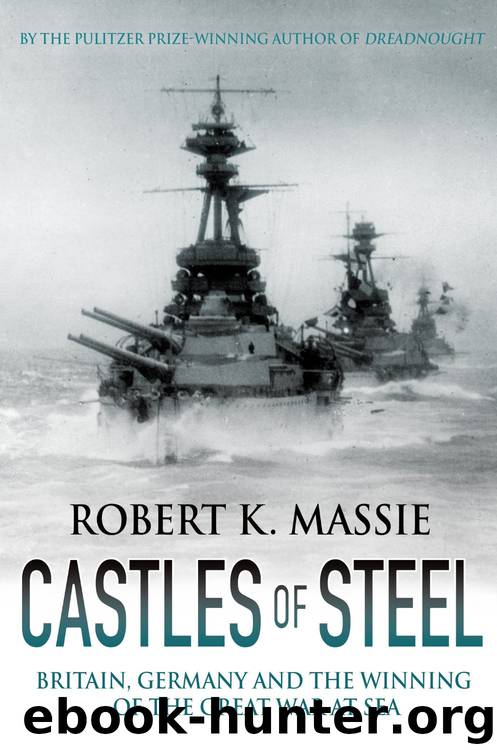Castles of Steel: Britain, Germany and the Winning of the Great War at Sea by Robert K. Massie

Author:Robert K. Massie [Massie, Robert K.]
Language: eng
Format: epub
Tags: Non Fiction, Military
ISBN: 9781844134113
Publisher: Pimlico
Published: 2015-12-24T16:00:00+00:00
CHAPTER 24 The Minefields
The whole fourteen-mile length of the Straits from the entrance at Cape Helles up to the Narrows at Chanak was within range of different types of Turkish artillery; indeed, there was no point in this stretch of water where a hostile vessel could not be hit by direct fire. The defense was constructed in three layers. The entrance was guarded by the outer forts, old, crenellated masonry structures, built on the white cliffs of the northern or European side. The massive fort of Sedd el Bahr, built in the seventeenth century against the Venetians, housed a mixed group of guns: two 11-inch, four 10-inch, and four 6-inch guns, with ranges up to 8,000 yards; this seemed ample, as the distance across the mouth of the Straits was only 4,000 yards. Nearby, around the point, the Cape Helles fort contained two 9.4-inch guns, which could reach out to 10,000 yards. Across the Straits, on the low green banks of the southern or Asian side, the Kum Kale fort housed two 11-inch, four 10-inch, one 8-inch, and two 6-inch guns. Another fort on the Asian shore contained two 9.4-inch guns. In sum, a total of sixteen heavy and seven medium-range guns defended the entrance to the Dardanelles. Inside the entrance where the Straits widen to four and a half miles, the Turks had established an intermediate defense consisting of medium guns, mostly 6-inch, situated in five permanent batteries, one on the European side, the other four on the Asian side. After the Allied bombardment in November 1914, the Germans and Turks made additions to this intermediate defense, bringing in eight mobile 6-inch howitzer batteries of four guns each. The number of searchlight batteries covering the minefields was increased to eight.
The ultimate defense of the Dardanelles lay at the Narrows, fourteen miles upstream from the entrance. Here, where Leander supposedly swam and where Xerxes built his bridge of boats, the channel is less than a mile across. The Narrows were protected by two massive ancient fortresses, at Kilid Bahr on the European shore and Chanak Kale on the Asian. In front of each of these old citadels, just above the beach, fortifications with heavy earth parapets had recently been constructed. Here, the Turks had mounted seventy-two guns of differing ranges and calibers, ranging from 14-inch and 11-inch down to 9.2-inch. Although less than a score of these guns were of modern design and ammunition was limited, they posed a formidable obstacle. And more ominous even than the guns were the minefields laid just below the Narrows, between Kephez and Chanak. Here, 324 mines were arranged in ten lines, ninety yards apart.
To overwhelm these defenses, the Admiralty collected warships from around the world. Admiral Carden was given the new superdreadnought Queen Elizabeth with eight 15-inch guns, the battle cruiser Inflexible with eight 12-inch guns, and twelve British and four French predreadnought battleships carrying a total of fifty-six 12-inch and eight 10-inch guns. Eight of the old battleships—Cornwallis, Irresistible, Ocean, Albion, Canopus,
Download
This site does not store any files on its server. We only index and link to content provided by other sites. Please contact the content providers to delete copyright contents if any and email us, we'll remove relevant links or contents immediately.
| General | Channel Islands |
| England | Northern Ireland |
| Scotland | Wales |
Room 212 by Kate Stewart(5040)
The Crown by Robert Lacey(4724)
Endurance: Shackleton's Incredible Voyage by Alfred Lansing(4677)
The Iron Duke by The Iron Duke(4293)
The Rape of Nanking by Iris Chang(4139)
Joan of Arc by Mary Gordon(4016)
Killing England by Bill O'Reilly(3953)
Say Nothing by Patrick Radden Keefe(3903)
I'll Give You the Sun by Jandy Nelson(3359)
Shadow of Night by Deborah Harkness(3305)
Hitler's Monsters by Eric Kurlander(3269)
Mary, Queen of Scots, and the Murder of Lord Darnley by Alison Weir(3152)
Blood and Sand by Alex Von Tunzelmann(3140)
Darkest Hour by Anthony McCarten(3072)
Eleanor & Park by Rainbow Rowell(3063)
Margaret Thatcher: The Autobiography by Thatcher Margaret(3029)
Red Famine: Stalin's War on Ukraine by Anne Applebaum(2873)
Book of Life by Deborah Harkness(2868)
The One Memory of Flora Banks by Emily Barr(2803)
